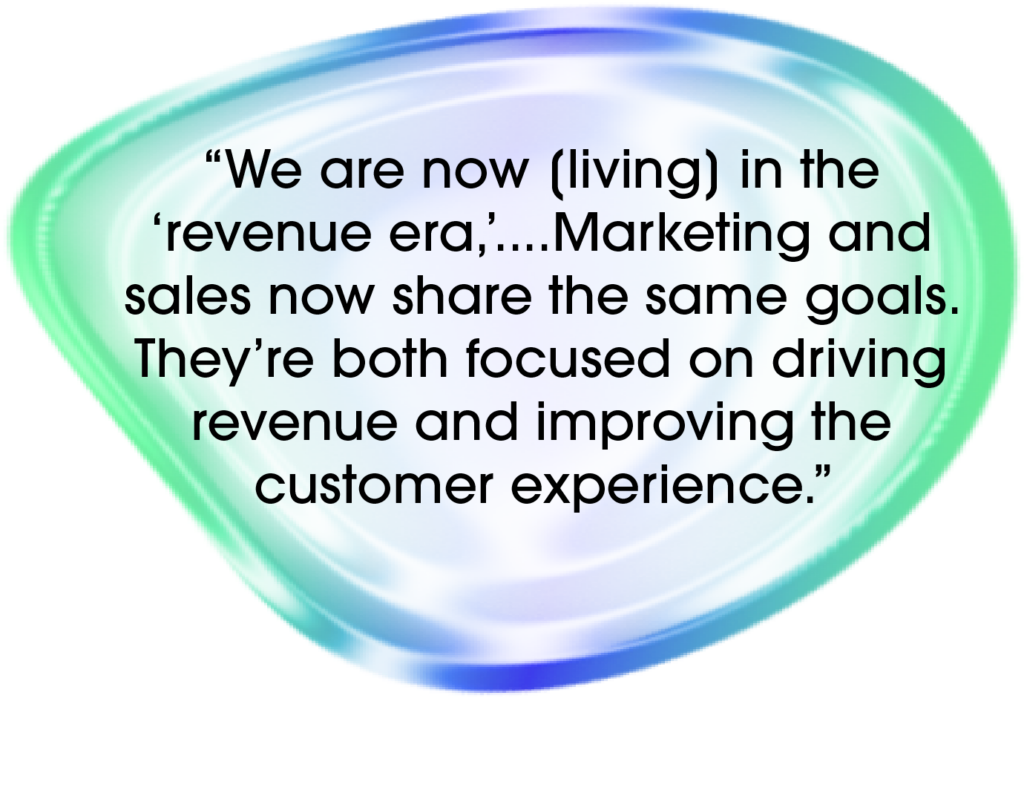TL;DR? Aligning your Lifecycle Stages, Lead Statuses, Deal Stages, Required Fields & Automations are the fastest way to get traction with your B2B business
We feel so strongly about this process we wrote a playbook to help clients with it: The Hands-On HubSpot Playbook, which you can download now for the unbeatable price of FREE.
“Align your marketing and sales teams” is a directive we’ve all heard countless times—but what does aligning marketing and sales departments really entail? Meetings? KPIs? Revised organizational charts?
The conflict between Marketing and Sales departments isn’t new. Harvard Business Review published “Ending the War Between Sales and Marketing” back in 2006, yet there’s still a widespread ongoing problem with syncing these teams. For B2B revenue teams, the conflict between these two camps is so common and costly it’s been dubbed “the trillion-dollar problem”
Many blogs, e-books and how-to guides offer generic action steps to solve the problem, from “create shared goals” to “collaborate on strategy and planning.” But if these general tips were effective, I wouldn’t hear over and over from clients that this departmental disconnect is still one of their biggest stumbling blocks.

So, here’s how my team and I help businesses get beyond what they know they “should” do (i.e. work together) and help them actually make the structural changes in HubSpot that let them shift their Marketing and Sales teams from unintentional adversaries to reliable partners.
1. Define your terms, then align and clean up your Lifecycle, Lead Status & Deal Stages.
You cannot align your marketing and sales teams unless you address why they are out of sync—and for most B2B companies, the “why” is the fact that they are defining their terms differently.
What qualifies as a lead? What makes a marketing qualified lead (MQL) or a sales qualified lead (SQL)? All of your teams need to DEFINE these terms the same way. Unless you arrive at consensus from staff on your terms and stages, you’ll struggle to grow revenue, and your Marketing and Sales teams will continue to clash or stall out.
Getting consensus on what qualifies as a lead or a valuable prospect will require time, conversation and likely some haggling between your departments—but you must get buy-in from the people that will be operating by these company-wide definitions and practices.
The default lead statuses in HubSpot can be customized to meet your business’s needs—but how you label them matters far less than getting the group to agree:
Which leads do you need to get in touch with today?
What makes a lead unqualified?
What counts as a contact attempt?
Your Marketing and Sales staff need a unified understanding of what these statuses mean within your organization.
Once you’ve arrived at consensus with your terms and your process, you have to make sure your unified source of truth (the data Marketing and Sales lean on to make decisions) is cleaned up. Are there legacy team members who haven’t been integrated into the system? Are there random extra statuses clogging the pipes? Along with your unified definitions of terms and action items, you need accurate, reliable data that everyone can use.
Invest your time and resources in getting this step right, because it’s the foundation of your future success.
2. Define, align and clean up your Fit Score and your Intent Score.
A fit score tells you whether a company is a good fit to be your customer, using data details such as industry, country, number of employees, a contact’s title, whether they’ve engaged with your website and brand across the internet.
An intent score indicates a lead’s likelihood to buy. While the fit score ranks your level of interest in a lead, the intent score ranks their level of interest in you. Have they indicated interest and engagement (visiting your site, downloading your content, responding to emails)?
You need smart scoring to tell you which leads are most valuable—and again, you need consensus across Marketing and Sales on how you’re scoring leads.
3. Define, align and clean up your required fields and automated property changes.
Based on your Lifecycle stage and Lead scores, you then need to add automations that shift contacts to low priority or high priority. With previously agreed-upon rules of engagement and consensus on terms, this layer of automation will save your people countless hours, time and energy.
According to McKinsey, 30% of all sales activities can now be automated. Use the amazing tools in HubSpot to give your people back the time they need to succeed at their jobs.
4. Define, align and clean up your Goals & Reporting.
Again, while the concept of shared goals across departments is in every single tips list on how to align Marketing and Sales, my client experience has shown me that creating and living by shared goals is sort of like eating your vegetables. Everyone knows it’s a thing you need to do for your health or your business’s health—but actually putting the time and energy into doing it regularly is what sets you apart.

Traditionally, Marketing was responsible for leads, while Sales was responsible for revenue. But as Corey Peterson at MarTech wrote, “We are now [living] in the ‘revenue era,’….Marketing and sales now share the same goals. They’re both focused on driving revenue and improving the customer experience.” Just like defining your terms and your action steps, defining achievable goals with input from your Marketing and Sales teams is essential.
Once you’ve got shared goals established, it’s time to aid your people in reaching those goals by automating your reporting! Halfway through the month, everyone needs a notification about how near or far you are from hitting your goals. Use automation to keep teams on the same page, using the same data.
Syncing your Marketing and Sales teams may be an industry-wide trillion dollar problem—but it’s not an unsolvable one. The future is bright for B2B businesses that actually eat their vegetables and do the daily work necessary to align their departments and their CRMs around mutually agreed-upon, shared goals.
After thousands of hours of coaching clients on HubSpot, we know the common roadblocks that frustrate users.
That’s why we created The Hands-On HubSpot Playbook: to give you and your team concrete, clearly explained action steps that will improve your process, streamline your workflow and enable your teams to work in harmony.

